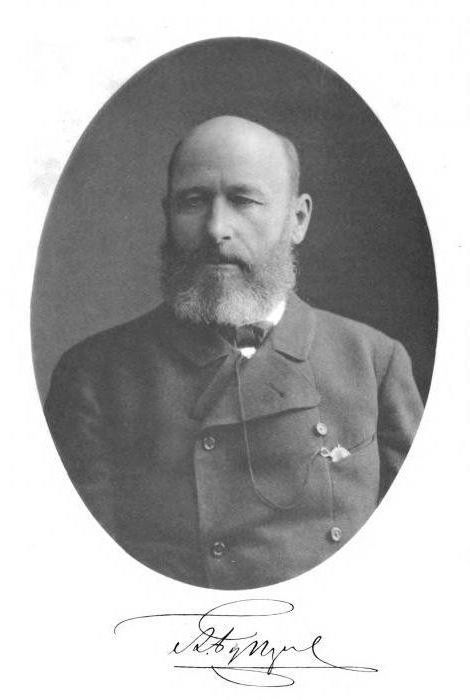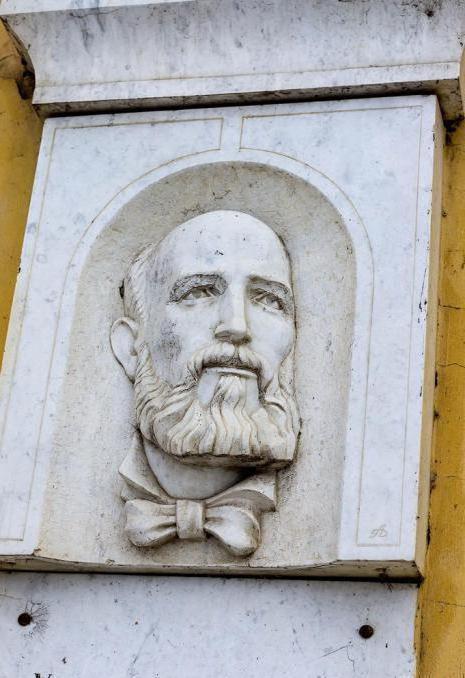Butlerov’s biography, which you will find in this article, is marked by the creation of a theory of the chemical structure. This theory today lies at the heart of the science of the nature of chemical compounds.
Butlerov’s biography begins in 1828, when Alexander Mikhailovich was born in the small village of Butlerovka, not far from Kazan. This event took place in the estate of his father.
Butlerov Alexander Mikhailovich: childhood
Alexander did not remember his mother, since she died 11 days after the birth of her son. His father was an educated man, and the future scientist wanted to be like him in everything. First, the boy went to a boarding school, and then he began to study at the First Kazan Gymnasium. In this educational institution there were very experienced teachers who knew how to arouse interest in their subjects. Learning was easy for Alexander; he was especially attracted to the natural sciences.
Classes at Kazan University, moving to Kazan
Contrary to the wishes of his father, after graduating from high school, Alexander Mikhailovich decided to become a student of the natural sciences department of the university in Kazan. A year later, in 1845, he was accepted to the first year. At this time, the young man turned 17 years old.
Butlerov’s biography was marked in 1846 by an unpleasant event - he fell ill with typhus. The guy miraculously survived, but his father, who became infected by him, died. Butlerov moved with his aunt to Kazan in the fall. He studied hard at the university, but soon noticed that he liked most of all lectures in chemistry. He was not satisfied with the lectures of Professor Klaus, so he began to attend classes that were taught by Nikolai Nikolaevich Zinin. The latter, observing Alexander during laboratory work, remarked that he was gifted.
PhD defense
To obtain a candidate’s degree, Alexander Mikhailovich had to submit a dissertation at the end of the university. Zinin by this time had left for Petersburg from Kazan. Therefore, Alexander had to do the natural sciences. He prepared an article for his Ph.D. work entitled "Daytime Butterflies of the Volga-Ural Fauna". But after some time, circumstances developed so that Butlerov still returned to chemistry.
Work at Kazan University
After receiving the degree, Alexander stayed to work at Kazan University. Klaus, the only professor of chemistry, could not conduct all the classes himself and needed an assistant, who became Alexander Mikhailovich. Butlerov passed the exams in the autumn of 1850 and became a master of chemistry. He immediately began working on a doctoral dissertation on the topic of essential oils. Butlerov defended this work early next year. Along with the preparation of lectures, Alexander Mikhailovich took up a thorough study of the history of chemistry.
Butlerov nerd
Butlerov’s biography is of interest not only to chemists, but also to botanists. Alexander Mikhailovich conducted experiments in his greenhouses, located in Butlerovka and Kazan. Also wrote articles on floriculture, horticulture and agriculture Alexander Butlerov. A photo of the monument to Alexander Mikhailovich, located in Kazan, near the university, is presented below.
Doctoral degree, business trip abroad, contribution to chemistry
Butlerov June 4, 1854 received a doctorate in physics and chemistry. Immediately after that, he was appointed to the post of acting professor of chemistry at his native Kazan University. Butlerov by the beginning of 1857 was already a professor. In the same year, in the summer, he received permission to go on a business trip abroad.
Alexander Mikhailovich arrived in Berlin at the end of the summer. After some time, he continued his journey through Germany, Italy, Switzerland and France. Paris was the ultimate destination of the trip. At that time, it was a world center for the study of chemistry. Butlerov was mainly attracted by the meeting with Adolf Wurz. Alexander Butlerov worked for 2 months in his laboratory. The chemist began to conduct his experiments here. After some time, his research brought the first fruits. Over the next 20 years, Alexander Butlerov discovered dozens of reactions and substances. The contribution to his chemistry was simply enormous. In addition, the model syntheses he carried out of ethylene and ethanol, tertiary alcohols, dinzobutylene, trioxymethylene, urotropine are at the origins of a number of industries. They had a stimulating effect on its development. As you can see, Alexander Butlerov did a lot for science and industry. Achievements are hard to overestimate. Now let's talk about the theory created by this chemist.

Butlerov's theory
Butlerov, studying hydrocarbons, realized that this is a separate class of chemicals. The scientist, analyzing their properties and structure, noticed a strict regularity that formed the basis of the theory of chemical structure created by him.
Butlerov's report at the Paris Academy of Sciences was met with interest. A lively debate began. A few years later, during the second trip abroad, Alexander Mikhailovich presented the theory he created. He made a presentation at the 36th Congress of Doctors and Naturalists in Speyer, held in September 1861. Butlerov read his report on the topic "Something about the chemical structure of bodies." The scientist introduced the audience to his new theory of the structure of organic substances. He said that every atom that is part of the body takes part in its formation and acts with forces directed at the atoms surrounding it. It is because of this effect that atoms bind into a molecule, a chemical particle. He called the chemical structure the distribution of the action of these forces, which leads to the bonding of atoms. Thus, complex particles have a chemical basis, which is determined by the nature of the constituent parts, their chemical structure and quantity.

Note that even before Butlerov, the term "chemical structure" was used in the literature. However, the scientist rethought it and began to use it to define a new concept. The theory of chemical structure is the basis of all sections of modern synthetic chemistry.
Obtaining trimethylcarbinol
The happiest year in Butlerov’s life can be considered the 1863rd. Acting on acetyl chloride with dimethylzinc, the scientist for the first time in history received tertiary butyl alcohol, otherwise called trimethylcarbinol. In the literature, shortly afterwards, there were reports of the synthesis of butyl alcohols, primary and secondary. Isobutyl alcohol has been known to scientists since 1852. Then it was first isolated from vegetable oil. Now there was no question of any dispute, since there were 4 butyl alcohols, each of which was an isomer. This was a real triumph of structural theory.
Theory of Tautomerism
The period from 1862 to 1865 includes the main point of the new theory expressed by Butlerov, now the reversible isomerization of tautomerism. Its author believed that its mechanism consists in the splitting of molecules having the same structure and the union of their residues with the formation of new molecules with a different structure. The scientist spoke about the need to apply a dynamic approach to chemical processes. In other words, they should be considered as equilibrium. The authority of Alexander Mikhailovich as the author of the theory of tautomerism was even recognized by Peter Laar, a German chemist who coined the word "tautomerism".
Chemistry textbook
Now Butlerov’s task was to apply his structural theory to all compounds and reactions of organic chemistry, as well as to create a new textbook on organic chemistry. In the textbook, all phenomena should be considered through the prism of the theory created by him. Almost 2 years Butlerov worked on its creation. Three editions (from 1864 to 1866) published a book by Alexander Mikhailovich "Introduction to the complete study of organic chemistry." She far exceeded all textbooks known at that time. Butlerov’s work caused a revolution in science. Already in 1867, they began to prepare the translation and publication of this book in German. Then came translations in other major languages of Europe.
Rest in Butlerovka, work at St. Petersburg University
After finishing work on the book, Alexander Mikhailovich Butlerov was increasingly in his estate. His family came here several times a week. The youngest son, Volodya, who was 2 years old, loved to play in a meadow near the house. Butlerov Alexander Mikhailovich also liked to rest here. Interesting facts about him include a passion for growing flowers, as well as creating a collection of insects.
Butlerov now spent less time in the laboratory, but he followed the discoveries of scientists. On the initiative of Mendeleev, the famous chemist, in the spring of 1868, Alexander was invited to work at St. Petersburg University. Here he began to give lectures, and also organized his own chemical laboratory. The scientist has created a new teaching methodology. He offered a laboratory workshop, now universally accepted. Students during the classes were trained to work with chemical equipment.
Obtaining isobutylene
Butlerov continued his research in which he developed structural theory. He wanted to prove that a straight and branched carbon chain can have all kinds of organic compounds. Such an assumption stemmed from his theory. However, it was necessary to prove this in practice. Finally, the efforts of Alexander Mikhailovich were successful. He got the long-awaited isobutylene. Thus, the presence of a branched hydrocarbon chain has been proven.
Involvement in the public life of St. Petersburg
Butlerov, in addition to scientific activities, was actively involved in the public life of the Russian capital. The progressive public at that time was particularly concerned about the issue of female education. It was necessary for women to have access to higher education. For this, the Higher Women's Courses were created at the Medical Surgical Academy. In addition, Bestuzhev women's courses were organized at which Alexander Mikhailovich gave his lectures on chemistry.
Membership in the Academy of Sciences
The activities of this scientist were noted by the Academy of Sciences. Butlerov was elected in 1871 as an extraordinary academician, and after 3 years - and ordinary. Thanks to this, he received an apartment in the building owned by the Academy. Zinin Nikolai Nikolaevich lived here. The long-standing friendship with him was further strengthened by the close proximity.
last years of life
The life and work of Alexander Butlerov until the last years were connected with science. However, years passed, and classes with students became too difficult for Butlerov. The scientist decided to leave the university. He gave a farewell lecture on April 4, 1880. This decision was met with deep chagrin. It is known that the Academic Council asked Alexander Mikhailovich to stay. He was elected for another 5 years.
Butlerov limited his activities at the university as much as possible. He read only the main course and conducted classes in the laboratory several times a week. On August 5, 1886, Alexander Mikhailovich Butlerov died from a blockage of blood vessels. A photo of the chapel at Butlerov’s grave is presented above.